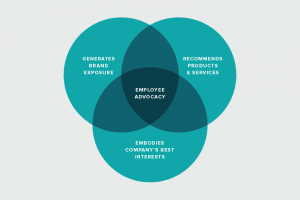Employee advocacy has been a buzzword in HR, sales and marketing departments alike for some time. What does employee advocacy really mean? Basically, it refers to the promotion of your organization by staff members. An employee advocate is someone who:
- Generates positive exposure and brand awareness via social media
- Recommends a company’s products or services
- Represents the core values of a company
- Is a credible spokesperson for your company

The Benefits of Employee Advocacy
Encouraging employees to openly represent your organization, internally and externally, is about more than generating a positive reputation. Yes, it does generally humanize your brand, but the effectiveness of employee advocacy reaches far beyond a “kumbaya” feeling of positivity and inclusivity. Just check out these metrics:
Close to half the world’s population (3.03 billion people) uses social media.
On top of that, 76% of individuals report they trust content shared by “normal” people more than content shared by brands.
In conclusion, employee advocacy, at first glance, seems to be a no-brainer tactic that could increase engagement tenfold.
How to Implement an Employee Advocacy Initiative
Although employee advocacy is not exactly rocket science, it can get complicated when you’re orchestrating a strategy for 100+ employees. Shoot, just organizing five employees can be tough! Regardless, it always helps to have a strategy when you’re deploying the initial push. The steps below should help you get started.
Know Which Departments to Utilize
I’m absolutely sure everyone at your organization is competent and would make excellent representatives of your brand. This point isn’t really to tell you who should be an employee advocate (that would be problematic), but to prioritize departments based on your promotional goals. For example, if you’re using employees to help with bottom line sales efforts, then utilize your sales team. If you’re using employee advocacy to raise brand awareness, maybe highlight your IT department—the people who actually solve technical problems. In other words, prioritize departments that are directly related to your promotional goals.
Use a Platform
If you don’t plan to use an employee advocacy tool to execute your employee advocacy program, quit while you’re ahead. I cannot stress the importance of using a platform enough. Using a platform makes employee participation 100x easier. It categorizes content in a strategic and useful manner. And once the content is out there, a platform will track engagements, providing data that empowers you to shift your strategy as necessary.
Some employee advocacy platforms to check out include:
Promote Appropriate Content on Respective Channels
This point is more of a friendly reminder than anything else. Remember that your brand voice will be different on Twitter than LinkedIn or Facebook, because each social platform has a distinct tone. LinkedIn is more professional and informative. Facebook is light, fluffy and fun-natured. Instagram likes clear images, and posts with people tend to receive higher engagement. Twitter is just a beast that needs to be fed—feed it as much as possible. To learn more about constructing a social strategy, download this outline: how to develop a social strategy.
Architect Your Employee Advocacy Program Today
The people at your organization are your most valuable asset. If you can design a protocol that encourages active engagement from all departments in marketing, then you’ll position yourself to increase engagements across the social board. If you’re interested in learning more about social trends, check out our blog, Social Trends for 2019.
Want to see some examples of our employee advocacy? Check out our Inside Access video.







